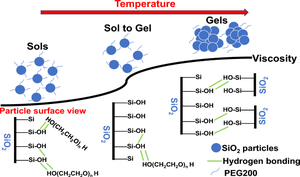Investigation of factors affecting the thermal stability of silica-based shear thickening fluids
Abstract
Recent experimental observation in thermal-induced gelation of silica-based shear thickening fluids (STFs) has necessitated the efforts to address the thermal instability of the STFs. The shear thickening behavior of hydrophilic fumed silica/PEG disappeared after thermal treatment. Hydrophobic surface is demonstrated to enhance thermal stability of the fumed silica/PEG system under the same thermal treatment. Dynamic temperature sweep experiments reveal a temperature-induced sol–gel transition of the hydrophilic silica/PEG. Meanwhile, hydrophobic silica/PEG does not undergo such gelation and still displays viscosity thickening after thermal treatment. This gelation process is found to be concentration-dependent and irreversible, with enhanced gelation at higher specific surface areas of hydrophilic silica particles. The small-angle X-ray scattering (SAXS) studies suggest that this sol–gel transition is likely attributed to the reduction of solvation layer which could be highly influenced by particle surface hydrophilicity. Comprehensive experiments, including Soxhlet extraction and rheology, confirm that the resulting stable three-dimensional structure is not formed by chemical crosslinks but behaves as a physical network. It is demonstrated how tailoring particle–medium interactions through controlling particle surface characteristics can be used to improve thermal stability of silica-based STFs.
Graphical abstract


 求助内容:
求助内容: 应助结果提醒方式:
应助结果提醒方式:


